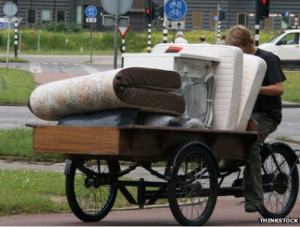One of the principle objectives of the Sustainable Penang 2013/New Mobility project is to seek out examples where leading cities in other parts of the world have taken the initiative explicitly to move from a car-dominated, basically no-choice transportation model ("Old Mobility") to a better mix of mobility options and more choices for everybody, what we call the New Mobility Agenda. In this report from Anna Holligan in yesterday's BBC News we have in a few pages some of the shaping elements of the story about why cycling has become such an important transportation option in Dutch cities and outlying areas. Penang could not only learn a great deal from better understanding the Dutch bike model, but also have in hand both the information and guidelines on how to adapt this approach to George Town and others towns and cities in Penang. That information is available, and a good place to start might be the Dutch Cycling Embassy at http://www.dutchcycling.nl/. But there are many others.
In this report from Anna Holligan in yesterday's BBC News we have in a few pages some of the shaping elements of the story about why cycling has become such an important transportation option in Dutch cities and outlying areas. Penang could not only learn a great deal from better understanding the Dutch bike model, but also have in hand both the information and guidelines on how to adapt this approach to George Town and others towns and cities in Penang. That information is available, and a good place to start might be the Dutch Cycling Embassy at http://www.dutchcycling.nl/. But there are many others.

Why is cycling so popular in the Netherlands?
- Anna Holligan. BBC News Magazine, 8 August 2013.
There are more bicycles than residents in The Netherlands and in cities like Amsterdam and The Hague up to 70% of all journeys are made by bike. The BBC's Hague correspondent, Anna Holligan, who rides an omafiets - or "granny style" - bike complete with wicker basket and pedal-back brakes, examines what made everyone get back in the saddle.
The 70s velo-rution
Before World War II, journeys in the Netherlands were predominantly made by bike, but in the 1950s and 1960s, as car ownership rocketed, this changed. As in many countries in Europe, roads became increasingly congested and cyclists were squeezed to the kerb.
The jump in car numbers caused a huge rise in the number of deaths on the roads. In 1971 more than 3,000 people were killed by motor vehicles, 450 of them children.
In response a social movement demanding safer cycling conditions for children was formed. Called Stop de Kindermoord (Stop the Child Murder), it took its name from the headline of an article written by journalist Vic Langenhoff whose own child had been killed in a road accident.
The Dutch faith in the reliability and sustainability of the motor vehicle was also shaken by the Middle East oil crisis of 1973, when oil-producing countries stopped exports to the US and Western Europe.
These twin pressures helped to persuade the Dutch government to invest in improved cycling infrastructure and Dutch urban planners started to diverge from the car-centric road-building policies being pursued throughout the urbanising West.
Path to glory
To make cycling safer and more inviting the Dutch have built a vast network of cycle paths.
These are clearly marked, have smooth surfaces, separate signs and lights for those on two wheels, and wide enough to allow side-by-side cycling and overtaking.
* The sign reads 'Bike street: Cars are guests' *
In many cities the paths are completely segregated from motorised traffic. Sometimes, where space is scant and both must share, you can see signs showing an image of a cyclist with a car behind accompanied by the words 'Bike Street: Cars are guests'.
At roundabouts, too, it is those using pedal power who have priority. . . .
- - - > For full text of her article click here.
# # #
Let me end this piece with the observation that getting cycling policy and practice right in your city is no longer about going to the moon or some other distant unknown place. The territory is well mapped. The Dutch and the Danes are perhaps leading the pack but the fact is that today there are hundreds of cities in various parts of the world that provide well documented examples both of measure and the processed behind them that any aspiring city can quickly contact and learn from. The only reason not to take advantage of this enormous wealth of material and knowledge has to be because . . . you just don't care.
 Print this article
Print this article



No comments:
Post a Comment
Thank you for your comment. You may wish to check back to the original entry from time to time to see if there are reactions to this. If you have questions, send an email to: editor@worldstreets.org